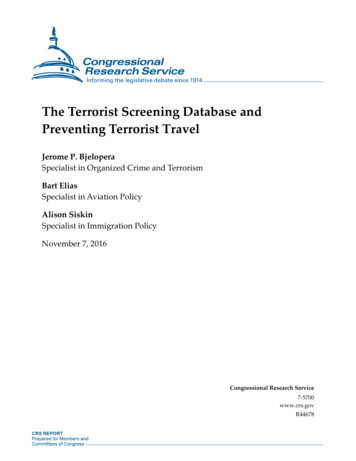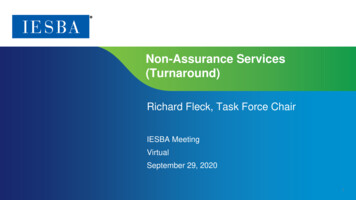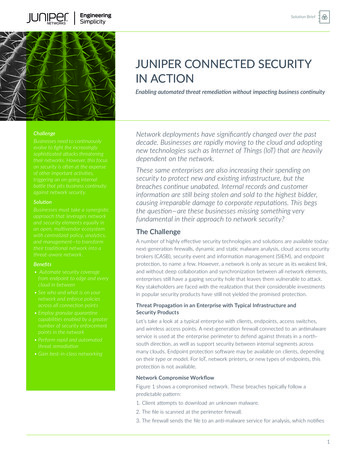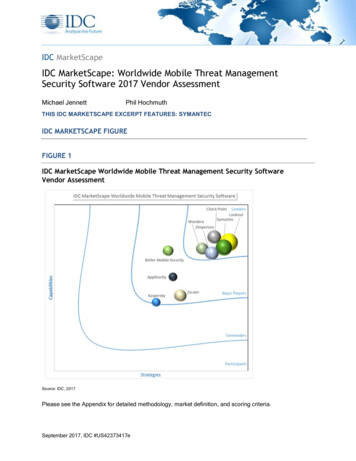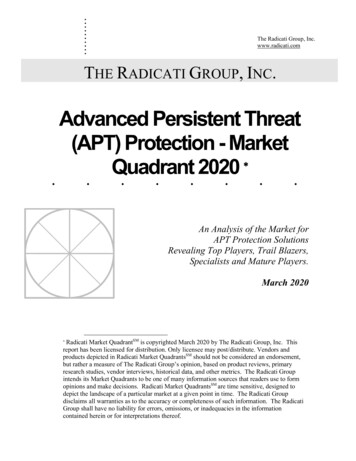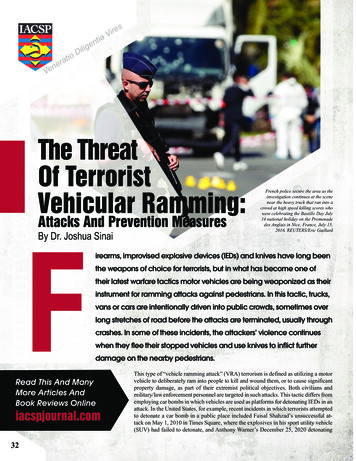
Transcription
The ThreatOf TerroristVehicular Ramming:Attacks And Prevention MeasuresFBy Dr. Joshua Sinaiirearms, improvised explosive devices (IEDs) and knives have long beenthe weapons of choice for terrorists, but in what has become one oftheir latest warfare tactics motor vehicles are being weaponized as theirinstrument for ramming attacks against pedestrians. In this tactic, trucks,vans or cars are intentionally driven into public crowds, sometimes overlong stretches of road before the attacks are terminated, usually throughcrashes. In some of these incidents, the attackers’ violence continueswhen they flee their stopped vehicles and use knives to inflict furtherdamage on the nearby pedestrians.Read This And ManyMore Articles AndBook Reviews Onlineiacspjournal.com32French police secure the area as theinvestigation continues at the scenenear the heavy truck that ran into acrowd at high speed killing scores whowere celebrating the Bastille Day July14 national holiday on the Promenadedes Anglais in Nice, France, July 15,2016. REUTERS/Eric GaillardThis type of “vehicle ramming attack” (VRA) terrorism is defined as utilizing a motorvehicle to deliberately ram into people to kill and wound them, or to cause significantproperty damage, as part of their extremist political objectives. Both civilians andmilitary/law enforcement personnel are targeted in such attacks. This tactic differs fromemploying car bombs in which vehicles are used as platforms for detonating IEDs in anattack. In the United States, for example, recent incidents in which terrorists attemptedto detonate a car bomb in a public place included Faisal Shahzad’s unsuccessful attack on May 1, 2010 in Times Square, where the explosives in his sport utility vehicle(SUV) had failed to detonate, and Anthony Warner’s December 25, 2020 detonatingJournal of Counterterrorism & Homeland Security InternationalVol. 26, No.3
of explosives in his recreational vehicle indowntown Nashville, TN, which severelydamaged the nearby buildings.The use of vehicular ramming tactics in aterrorist group’s warfare, while long usedin conflict zones such as the Middle East(especially in Israel and the West Bank) andelsewhere, is relatively recent in the West,including the United States. In the U.S.,the first car ramming attack after 9/11 tookplace on March 3, 2006 when MohammedReza Taheri-azar, an Iranian-American, intentionally rammed his SUV at the campusof the University of North Carolina (UNC)in Chapel Hill, injuring nine persons.July 14, 2016:Mohamed LahouaiejBouhlel, a radicalizedTunisian living inFrance, drove a 19crowds on BastilleThe following is a representative sample oftwenty incidents in which terrorists haveused the tactic of vehicle ramming againstcrowds of people in their attacks over thepast 17 years. Numerous other incidentsinvolving terrorists’ ramming of vehiclesin their attacks have occurred during thisperiod, especially in Israel (and in the WestBank), so this listing is intended to serveas a preliminary account, to be expandedin other projectskilling 86 people and December 6, 2004: An al Qaida celldrove two vehicles to storm throughthe fortified gate of the U.S. Consulatein Jiddah, Saudi Arabia, and launcheda three-hour gun battle that led to thekilling of five consulate employees,including the four attackers.March 3, 2006: Mohammed RezaTaheri-azar, an Iranian-American,intentionally rammed his SUV at thecampus of the University of North Carolina (UNC) in Chapel Hill, woundingnine persons.October 26, 2015: A man smashedhis stolen car through the gates of anarmy barracks in Flawinne, southernBelgium, and continued driving thevehicle after shots were fired by thesecurity guards. He was shortly thereafter arrested.January 1, 2016: A man drove a carat four soldiers guarding a mosquein Valence, in southeastern France,injuring one of the soldiers. When hereturned for a second pass, they shotand wounded him.July 14, 2016: Mohamed Lahouaiej- ton cargo truck intoIncidents of VehicleRamming Attacks, 2004-2021 Day in Nice, France,wounding 458 others. Bouhlel, a radicalized Tunisian livingin France, drove a 19-ton cargo truckinto crowds on Bastille Day in Nice,France, killing 86 people and wounding 458 others.November 28, 2016: Abdul Razak AliArtan a Somali refugee, drove his carinto a crowd at Ohio State University,in Columbus, OH, where he was astudent, and then got out of his crashedvehicle and attempted to stab others. Intotal, 11 people were wounded.December 19, 2016: Anis Amri, aTunisian, Berlin, drove a truck intoa crowd at a Christmas market inBerlin, Germany, killing 12 peopleand wounding 56 others.March 22, 2017: Khalid Masooddrove a SUV into a crowd along thepavement of Westminster Bridge,in the vicinity of the British Parliament, in London, England. Fourpeople were killed and more than50 others wounded. After the driveleft his vehicle, a stabbed a policeofficer. Masood was then shot by aresponding police officer.April 7, 2017: Rakhmat Akilov,rejected asylum seeker and citizen ofUzbekistan, drove his hijacked lorrytruck into a department store in Stockholm, Sweden, killing five people andwounding 14 others.June 3, 2017: Three radicalized Muslim male assailants drove their van intocrowds on London Bridge, England,after which the attackers left theirvehicle and stabbed several people inthe area. Seven people were killed and48 others injured.June 19, 2017: Darren Osborne drovehis van into a group of pedestrians attending late-night prayers at FinsburyPark Mosque, in London, England,killing one person and wounding 11others.August 12, 2017: James Alex FieldsJr. drove from Ohio to Charlottesville,Virginia, to attend a neo-Nazi rally,where he deliberately drove his carinto a crowd of counter-rally protestors, killing one person and woundingseveral dozen others. He was immediately arrested.August 17, 2017: Three radicalizedMuslims deliberately drove a rentedvan into pedestrians in the Las Ramblastourist area, in Barcelona, Spain, killing13 and wounding more than 100 others.
34 September 30 2017:Abdulahi Hasan Sharif, aradicalized Somali refugee,deliberately drove his SUVat a police officer outside afootball game, in Edmonton,Canada, after which he jumped outof the vehicle and stabbed the officer with a knife. After fleeing, herented a U-Haul truck which he usedto drive into pedestrians, woundingfour people.October 31, 2017: SayfulloHabibullaevich Saipov drove arented pickup truck down a bicyclepath near the World Trade Center, inNew York City, killing eight peopleand wounding almost a dozen others. After crashing his truck into aschool bus, he got out of his vehicleand brandished a BB gun. He wasimmediately shot to death by a responding police officer.April 23, 2018: Alek Minassian,an adherent of the extremist Incelmovement, drove his rented vanthrough a business district in Toronto, Ontario, Canada, and deliberately targeted pedestrians, killing10 and wounding 16 others. He wastaken into custody by the responding police.May 14, 2020: Bahaa MuhammadAbdullah Alawada, age 15, a Palestinian, deliberately drove his car atan Israeli soldier in Hebron, WestBank/Israel, seriously woundinghim. Alawada was shot dead by theresponding Israeli military forces.October 19, 2020: Three to fourmen of Pakistani origin drove adark BMW, which was followed bya Mercedes, and attempted to hit asecurity officer outside the Israeliembassy in Paris, France. The security officer dodged the vehiclesand was not hurt. The suspects werearrested the following day.January 9, 2021: Two Palestiniansattempted a car-ramming attack againstIsraeli soldiers at a military checkpointnear the Palestinian village of Ya’badin the West Bank. An IDF soldierwas hit, but did not require medicalattention. After driving away , theyopened fire on Israeli troops stationedat a nearby checkpoint. The Palestinianattackers managed to escape, but werearrested several days afterwards.AssessmentAs demonstrated by these twenty incidents,there are three basic types of vehicle ramming attacks.The ideologicalmotivation forconducting vehicularramming attacks issimilar to the ideologythat motivatesterrorists in general:In the first type, which is predominant,the vehicles are intentionally driven intopublic crowds to cause as many fatalitiesand injuries as possible.In the second type, the vehicles are used toram into crowds but as part of an additionaltactic in which the vehicle’s driver will getout and attempt to stab or shoot as manyadditional victims as possible.of violence availableIn the third type, the vehicles are used tobreach a hardened target’s security by driving past its security gate to conduct a furtherattack within its compound, if possible.to them to inflictIdeological Motivationemploying any meanshuman, physical,and psychologicaldamage on theirtargeted adversariesin order to, punishthem, publicize theircause, and coercethem to accede totheir demands.Journal of Counterterrorism & Homeland Security InternationalThe ideological motivation for conducting vehicular ramming attacks is similarto the ideology that motivates terrorists ingeneral: employing any means of violenceavailable to them to inflict human, physical,and psychological damage on their targetedadversaries in order to, punish them, publicize their cause, and coerce them to accedeto their demands.In the case of Islamist extremists, groups suchas al Qaida and the Islamic State have calledon their supporters to use vehicles as weapons.In September 2014, for example, Abū Bakral-Baghdadi, ISIS’s late leader, called on thegroup’s lone actor adherents to use whateverweapons or devices, including vehicles, to kill“infidels.” Al Qaida, the Islamic State’s rival,had earlier published an article in its “Inspire”magazine, “recommending wannabe jihadists[to] consider car rammings as a particularlyeffective terrorist tactic.”With vehicle ramming attacks also used byfar-right-wing extremists, especially at ralliesagainst street protesters they regard as theiradversaries, this tactic has become commonto terrorist groups of all ideological types.Tactics, Techniques andProcedures (TTPs)Terrorists’ tactics, techniques, and procedures (TTPs) continuously adapt and evolveVol. 26, No.3
in response to changingresponses by their government adversaries, especiallywhen they harden their defenses against certain typesof attacks. As demonstratedby the 20 selected incidents, terrorists,especially lone actors whose primaryaffiliation with a terrorist group is theiradherence to the group’s extremist ideology and objectives, are increasinglyemploying the vehicular ramming tacticin their warfare. It is a weapon of choicefor them because vehicles are easilyacquirable, especially through vehiclerental agencies (or through theft), andthey are virtually impossible to beidentified as a potentially suspiciousattacker. In fact, the vehicles enable theperpetrators to become “smart attackers” because they can make their wayto their targets and change direction, ifneeded, to inflict maximum lethalityin their attacks. Finally, using vehiclesenable these attackers to exploit the softtarget nature of public places wherepedestrians can be easily attacked bysuch moving vehicles.The tactics of employing vehiclesas weapons follow the five TTPs ofterrorist warfare. These consist of 1)attack preparation steps (such as acquiring the expertise and funding tolaunch a vehicular attack by decidingon whether to rent, steal or use theirown vehicle); 2) the execution timeline(such as identifying the timeline for anattack); 3) targeting (such as carryingout reconnaissance of a potential target, including identifying its potentialvulnerabilities); 4) the planning stage(collecting the resources for the attack,in this case, acquiring the vehicle); and5) the final execution stage (i.e., theactual vehicle ramming attack).One of the reasons for the recent frequency in vehicular attacks in NorthAmerica and Western Europe is theiroperatives’ inability to acquire weapons, ammunition or bomb-buildingmaterials legally, due to these countriesstrict gun control laws and possiblesurveillance of their activities shouldthey attempt to acquire a weapon from a36gun dealer. Vehicles, on the other hand,whether cars or trucks, are relativelyeasy to rent, and, in some cases even tosteal, to use as mass casualty weaponsagainst their adversaries.One of the reasons forthe recent frequencyin vehicular attacksin North Americaand Western Europeis their operatives’inability to acquireweapons, ammunitionor bomb-buildingmaterials legally, dueto these countriesstrict gun controllaws and possiblesurveillance of theiractivities should theyattempt to acquirea weapon from agun dealer. Vehicles,on the other hand,whether cars or trucks,are relatively easyto rent, and, in somecases even to steal, touse as mass casualtyConclusionsWith vehicular ramming attacks becoming increasingly prevalent among terrorists of all ideological types, especiallywhen they see that such attacks generatemassive publicity for their perpetratorsand causes, several protective measurescan be implemented in preventing or,at least, mitigating the impact of suchtactics in their warfare. First, a crucialphysical protection measure is theplacement of concrete barriers, such asbollards, since they keep vehicles fromdriving up onto pedestrian areas. Thisis especially important at special eventsthat are held outdoors, where barriersneed to be erected to prevent potentialvehicular attacks. A second related measure is enhanced situational awareness.While there are no specific types ofvehicles that could be linked to a potential terrorist attack, suspicious drivingpatterns by an incoming vehicle couldindicate that an attack might be underway. Third, since several attacks involverental vehicles, a reporting guidelinesand procedures protocol system needs tobe established for employees at vehiclerental companies to report suspiciousactivities by customers with a potentialterrorist intent. Finally, since terroristsand those who aspire to engage in terrorist attacks tend to leak their threatintentions in extremist social media sites,when their posts reveal an intention touse vehicles as their weapon of choice,such postings need to be reported to theappropriate law enforcement authoritiesfor preemptive preemption.weapons against theirAbout the Authoradversaries.Dr. Joshua Sinai is a Professor of Practice, Counterterrorism Studies, at Capitol Technology University, in Laurel, MD (www.captechu.edu). He is also asenior analyst at TorchStone Global, a security andprotection firm (www.torchstoneglobal.com). He alsoteaches a graduate level distance learningcourse on “Global Terrorism” at Southern New Hampshire University. He can bereached at: Joshua.sinai@comcast.net.Journal of Counterterrorism & Homeland Security InternationalVol. 26, No.3
In the case of Islamist extremists, groups such as al Qaida and the Islamic State have called on their supporters to use vehicles as weapons. In September 2014, for example,Abū Bakr al-Baghdadi, ISIS’s late leader, called on the group’s lone actor adherents to use

